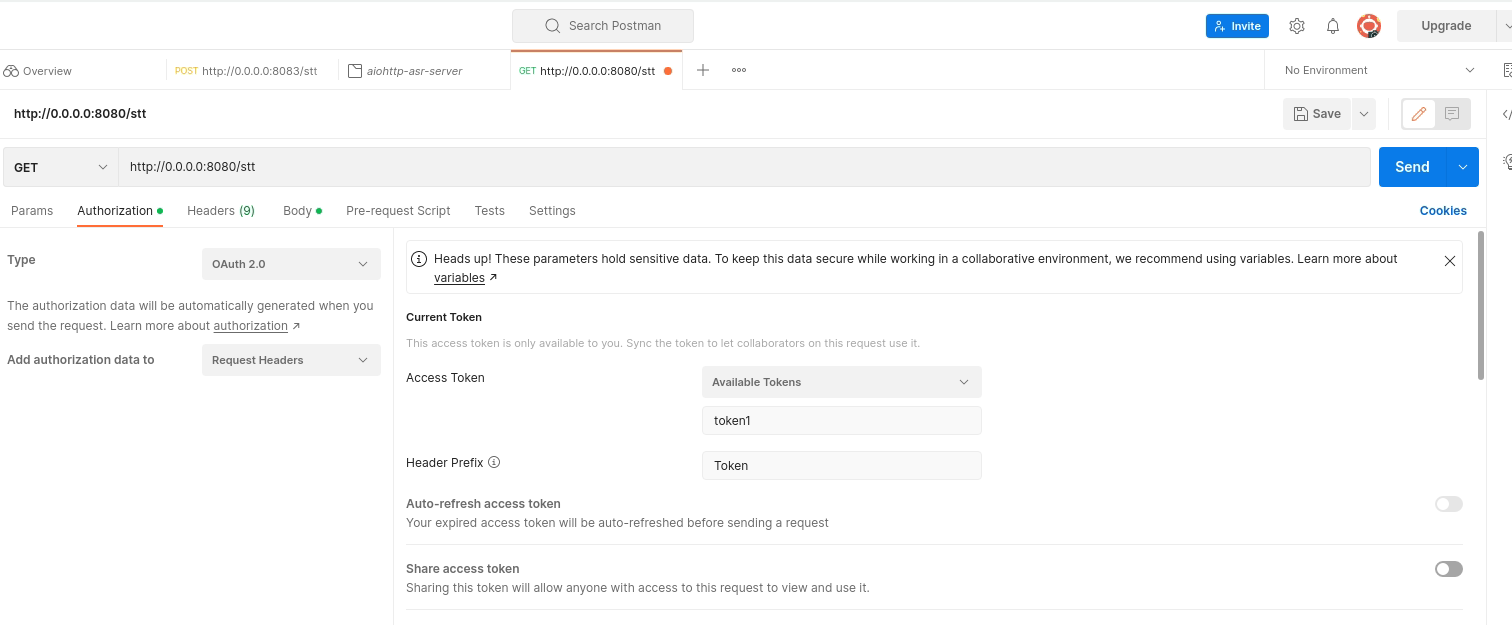Whisper based speech recognition server#
In the last blog post: Token authenticated aiohttp server, an authenticated aiohttp server was introduced. In this post, we build on top of the previous posts, to create an Automatic Speech Recognition (ASR) authenticated server, that uses the newly introduced whisper by OpenAI.
Speech recognition implementation#
There are different approaches to implement this. The choice here is arbitrary, I chose whisper since it is accurate and simple to integrate. One way to implement this is to use the whisper transcribe function. This can be done as follows:
1 import io
2 import sys
3 import time
4 import asyncio
5 import logging
6 import whisper
7 import subprocess
8 import soundfile as sf
9
10
11 # load model
12 model = whisper.load_model("base")
13
14 async def stt(request):
15 """
16 Speech to text routine to transcribe incoming wave audio and deliver
17 the resulting text in return.
18
19 Args:
20 request.
21
22 Returns:
23 Json response.
24 """
25 response = {}
26 stime = time.time()
27 bytes_data = await request.content.read()
28 logger.debug("size of received bytes data: " + str(sys.getsizeof(bytes_data)) + " bytes")
29
30 try:
31 # save temp file
32 audio, fs = sf.read(io.BytesIO(bytes_data), dtype="float32")
33 result = model.transcribe(audio=audio)
34 texts = result['text']
35 tproc = round(time.time() - stime, 3)
36 response = {"text": ' '.join(texts), "proc_duration": tproc, "status": "success"}
37
38 except Exception as e:
39 response = {"Error": str(e), "status": "failed"}
40 logger.error("-> Errror :" + str(e))
41
42 return web.json_response(response)
The config#
We will be using the same config specified in Token authenticated aiohttp server/config Note the allowed_tokens sections, that can be replaced by your own server allowed tokens.
Code#
The previously listed steps, should look together in Python as follows:
1import io
2import sys
3import json
4import time
5import asyncio
6import logging
7import whisper
8import subprocess
9import soundfile as sf
10from aiohttp import web
11from typing import Callable, Coroutine, Tuple
12
13
14# init loggging
15logger = logging.getLogger(__name__)
16logging.basicConfig(format="[%(asctime)s.%(msecs)03d] p%(process)s {%(pathname)s: %(funcName)s: %(lineno)d}: %(levelname)s: %(message)s", datefmt="%Y-%m-%d %p %I:%M:%S")
17logger.setLevel(10)
18
19# load model
20model = whisper.load_model("base")
21
22# parse conf
23with open("config.json", "rb") as config_file:
24 conf = json.loads(config_file.read())
25
26def ping(request):
27 logger.debug("-> Received PING")
28 response = web.json_response({"text": "pong", "status": "success"})
29 return response
30
31async def stt(request):
32 """
33 Speech to text routine to transcribe incoming wave audio and deliver
34 the resulting text in return.
35
36 Args:
37 request.
38
39 Returns:
40 Json response.
41 """
42 response = {}
43 stime = time.time()
44 bytes_data = await request.content.read()
45 logger.debug("size of received bytes data: " + str(sys.getsizeof(bytes_data)) + " bytes")
46
47 try:
48 # save temp file
49 audio, fs = sf.read(io.BytesIO(bytes_data), dtype="float32")
50 result = model.transcribe(audio=audio)
51 texts = result['text']
52 tproc = round(time.time() - stime, 3)
53 response = {"text": ' '.join(texts), "proc_duration": tproc, "status": "success"}
54
55 except Exception as e:
56 response = {"Error": str(e), "status": "failed"}
57 logger.error("-> Errror :" + str(e))
58
59 return web.json_response(response)
60
61def token_auth_middleware(user_loader: Callable,
62 request_property: str = 'user',
63 auth_scheme: str = 'Token',
64 exclude_routes: Tuple = tuple(),
65 exclude_methods: Tuple = tuple()) -> Coroutine:
66 """
67 Checks a auth token and adds a user from user_loader in request.
68 """
69 @web.middleware
70 async def middleware(request, handler):
71 try : scheme, token = request.headers['Authorization'].strip().split(' ')
72 except KeyError : raise web.HTTPUnauthorized(reason='Missing authorization header',)
73 except ValueError : raise web.HTTPForbidden(reason='Invalid authorization header',)
74
75 if auth_scheme.lower() != scheme.lower():
76 raise web.HTTPForbidden(reason='Invalid token scheme',)
77
78 user = await user_loader(token)
79 if user : request[request_property] = user
80 else : raise web.HTTPForbidden(reason='Token doesn\'t exist')
81 return await handler(request)
82 return middleware
83
84async def init():
85 """
86 Init web application.
87 """
88 async def user_loader(token: str):
89 user = {'uuid': 'fake-uuid'} if token in conf["server"]["http"]["allowed_tokens"] else None
90 return user
91
92 app = web.Application(client_max_size=conf["server"]["http"]["request_max_size"],
93 middlewares=[token_auth_middleware(user_loader)])
94
95 app.router.add_route('GET', '/ping', ping)
96 app.router.add_route('GET', '/stt', stt)
97 return app
98
99if __name__ == '__main__':
100 web.run_app(init(),)
Testing#
The previous code when executed will start a server running on http://localhost:8080/.
To test your server, you can use curl curl -H 'Authorization: Token token1' http://localhost:8080/ping (note that you will need to pass a token as specified in the config and code).
As for the transcription function, this can be tested by passing the audio file to transcribe using curl -X POST --data-binary @WAVEFILENAME.wav http://127.0.0.1:8080/stt.
Alternatively, you can use Postman, which is a tool for developers to design, build and test their APIs.
For this, you will need to create you GET request, specify the API/server link, add your wave file to transcribe to the body (as binary) and you will need to specify your token in the headers.
This can be done under the authorization tab, choose OAuth 2.0 as type, then set the "Access Token" to an allowed token (specify this in the config)
"Header Prefix" to Token (this is the same as defined in def token_auth_middleware(.. auth_scheme: str = 'Token'..)).

Figure 20: Postman authorization config#
The server reponses should look as follows:
Ping response: {"text": "pong", "status": "success"}
Stt response: {"text": "transcription", "proc_duration": 0.xxx , "status": "success"}
Conclusion#
This blog built on top of the previous posts (Basic aiohttp server and Token authenticated aiohttp server) to deliver an ASR authenticated server based on whisper.